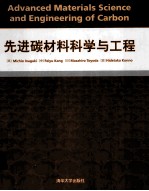图书介绍
先进碳材料科学与工程 英文版PDF|Epub|txt|kindle电子书版本下载

- (日)稻垣道夫等著 著
- 出版社: 北京:清华大学出版社
- ISBN:9787302347170
- 出版时间:2013
- 标注页数:434页
- 文件大小:74MB
- 文件页数:446页
- 主题词:碳-材料科学-英文
PDF下载
下载说明
先进碳材料科学与工程 英文版PDF格式电子书版下载
下载的文件为RAR压缩包。需要使用解压软件进行解压得到PDF格式图书。建议使用BT下载工具Free Download Manager进行下载,简称FDM(免费,没有广告,支持多平台)。本站资源全部打包为BT种子。所以需要使用专业的BT下载软件进行下载。如BitComet qBittorrent uTorrent等BT下载工具。迅雷目前由于本站不是热门资源。不推荐使用!后期资源热门了。安装了迅雷也可以迅雷进行下载!
(文件页数 要大于 标注页数,上中下等多册电子书除外)
注意:本站所有压缩包均有解压码: 点击下载压缩包解压工具
图书目录
CHAPTER 1 Introduction1
1.1 Classification of carbon materials2
1.2 Nanotexture of carbon materials5
1.3 Microtexture of carbon materials8
1.4 Specification of carbon materials10
1.5 Construction of the present book12
References12
CHAPTER 2 Carbon Nanotubes:Synthesis and Formation15
2.1 Synthesis of carbon nanotubes16
2.2 Formation of carbon nanotubes22
2.2.1 Formation into yarns22
2.2.2 Formation into sheets24
2.2.3 Formation into sponges29
2.3 Applications of carbon nanotubes30
2.4 Concluding remarks35
References36
CHAPTER 3 Graphene:Synthesis and Preparation41
3.1 Preparation through the cleavage of graphite42
3.2 Preparation through the exfoliation of graphite45
3.2.1 Preparation using graphite oxides45
3.2.2 Preparation using graphite intercalation compounds49
3.3 Synthesis through chemical vapor deposition50
3.4 Synthesis through the organic route56
3.5 Preparation through other processes57
3.6 Concluding remarks59
References62
CHAPTER 4 Carbonization Under Pressure67
4.1 Carbonization under built-up pressure68
4.1.1 Setup for carbonization under pressure68
4.1.2 Optical texture and carbonization yield68
4.1.3 Particle morphology70
4.2 Carbonization under hydrothermal conditions74
4.3 Carbonization under supercritical conditions78
4.4 Concluding remarks79
4.4.1 Temperature and pressure conditions for carbonization79
4.4.2 Composition of precursors for the formation of carbon spheres81
References84
CHAPTER 5 Stress Graphitization87
5.1 Graphitization under pressure88
5.1.1 Structural change in carbons88
5.1.2 Mechanism93
5.2 Graphitization in coexistence with minerals under pressure96
5.2.1 Coexistence with calcium compounds96
5.2.2 Coexistence with other minerals99
5.2.3 Mechanism for acceleration of graphitization99
5.3 Stress graphitization in carbon/carbon composites102
5.3.1 Acceleration of graphitization102
5.3.2 Mechanism105
5.4 Concluding remarks107
5.4.1 Graphitization under pressure107
5.4.2 Occurrence of graphite in nature108
5.4.3 Stress graphitization in carbon/carbon composites109
References109
CHAPTER 6 Glass-like Carbon:Its Activation and Graphitization111
6.1 Activation of glass-like carbon111
6.1.1 Glass-like carbon spheres111
6.1.2 Activation in a flow of dry air113
6.1.3 Activation in a flow of wet air117
6.1.4 Activation process118
6.1.5 Direct observation of micropores121
6.1.6 Two-step activation123
6.2 Graphitization of glass-like carbons124
6.2.1 Graphitization through melting124
6.2.2 Graphitization under high pressure126
6.2.3 Graphitization in C/C composites128
6.3 Concluding remarks130
References132
CHAPTER 7 Template Carbonization:Morphology and Pore Control133
7.1 Template carbonization for morphological control134
7.1.1 Inorganic layered compounds134
7.1.2 Anodic aluminum oxide films135
7.1.3 Organic foams138
7.2 Template carbonization for pore-structure control139
7.2.1 Zeolites139
7.2.2 Mesoporous silicas142
7.2.3 MgO145
7.2.4 Block copolymer surfactants(soft templates)149
7.2.5 Metal-organic frameworks153
7.2.6 Other templates154
7.3 Concluding remarks155
References159
CHAPTER 8 Carbon Nanofibers Via Electrospinning165
8.1 Carbon nanofibers synthesized via electrospinning166
8.1.1 Polyacrylonitrile166
8.1.2 Pitch170
8.1.3 Polyimides171
8.1.4 Poly(vinylidene fluoride)171
8.1.5 Phenolic resins172
8.2 Applications172
8.2.1 Electrode materials for electrochemical capacitors172
8.2.2 Anode materials for lithium-ion rechargeable batteries175
8.2.3 Catalyst support178
8.2.4 Composite with carbon nanotubes180
8.3 Concluding remarks180
8.3.1 Carbon precursors180
8.3.2 Pore-structure control182
8.3.3 Improvement of electrical conductivity184
8.3.4 Loading of metallic species185
References186
CHAPTER 9 Carbon Foams189
9.1 Preparation of carbon foams190
9.1.1 Exfoliation and compaction of graphite190
9.1.2 Blowing of carbon precursors193
9.1.3 Template carbonization198
9.2 Applications of carbon foams201
9.2.1 Thermal energy storage202
9.2.2 Electrodes207
9.2.3 Adsorption208
9.2.4 Other applications209
9.3 Concluding remarks210
References212
CHAPTER 10 Nanoporous Carbon Membranes and Webs215
10.1 Synthesis216
10.1.1 Pyrolysis and carbonization of organic precursors216
10.1.2 Templating219
10.1.3 Chemical and physical vapor deposition222
10.1.4 Formation of carbon nanotubes and nanofibers223
10.2 Applications224
10.2.1 Adsorbents224
10.2.2 Separation membranes225
10.2.3 Chemical sensors and biosensors228
10.2.4 Electrodes229
10.2.5 Other applications231
10.3 Concluding remarks231
References233
CHAPTER 11 Carbon Materials for Electrochemical Capacitors237
11.1 Symmetrical supercapacitors239
11.1.1 Activated carbons239
11.1.2 Templated carbons243
11.1.3 Other carbons246
11.1.4 Carbons containing foreign atoms248
11.1.5 Carbon nanotubes and nanofibers252
11.2 Asymmetrical supercapacitors254
11.3 Asymmetrical capacitors256
11.4 Carbon-coating of electrode materials258
11.5 Concluding remarks260
References261
CHAPTER 12 Carbon Materials in Lithium-ion Rechargeable Batteries267
12.1 Anode materials268
12.1.1 Materials268
12.1.2 Carbon coating of graphite270
12.1.3 Carbon coating of Li4Ti5O12275
12.2 Cathode materials278
12.2.1 Materials278
12.2.2 Carbon coating of LiFePO4279
12.3 Concluding remarks283
References284
CHAPTER 13 Carbon Materials in Photocatalysis289
13.1 TiO2-loaded activated carbons290
13.2 Mixture of activated carbon and TiO2295
13.3 Carbon-doped TiO2297
13.4 Carbon-coated TiO2300
13.5 Synthesis of novel photocatalysts via carbon coating305
13.5.1 Carbon-coated TinO2n-1305
13.5.2 Carbon-coated W18O49305
13.5.3 TiO2 co-modified by carbon and iron305
13.6 Concluding remarks306
References308
CHAPTER 14 Carbon Materials for Spilled-oil Recovery313
14.1 Sorption capacity for heavy oils314
14.1.1 Exfoliated graphite314
14.1.2 Carbonized fir fibers318
14.1.3 Carbon fibers318
14.1.4 Carbon nanotube sponge319
14.1.5 Other carbon materials320
14.2 Selectivity of sorption320
14.3 Sorption kinetics321
14.4 Cycle performance of carbon sorbents and heavy oils323
14.5 Preliminary experiments for practical recovery of spilled heavy oils326
14.5.1 Exfoliated graphite packed into a plastic bag326
14.5.2 Formed exfoliated graphite327
14.5.3 Heavy oil sorption from contaminated sand328
14.5.4 Sorption of heavy-oil mousse329
14.5.5 TiO2-loaded exfoliated graphite329
14.6 Concluding remarks329
14.6.1 Comparison among carbon materials329
14.6.2 Mechanism of heavy oil sorption331
14.6.3 Comparison with other materials332
References333
CHAPTER 15 Carbon Materials for Adsorption of Molecules and Ions335
15.1 Adsorption and storage of hydrogen336
15.2 Adsorption and storage of methane and methane hydrate339
15.3 Adsorption and storage of CO2343
15.4 Adsorption of organic molecules346
15.4.1 Organic gases(including VOCs)346
15.4.2 Organic molecules in water350
15.5 Adsorption and removal of heavy-metal ions in water353
15.6 Capacitive deionization354
15.7 Concluding remarks356
References357
CHAPTER 16 Highly Oriented Graphite with High Thermal Conductivity363
16.1 Preparation364
16.2 Characterization366
16.3 Carbon materials with high thermal conductivity370
16.3.1 Pyrolytic graphite370
16.3.2 Polyimide-derived graphite373
16.3.3 Natural graphite and its composites374
16.3.4 Carbon fibers376
16.3.5 Carbon nanotubes and graphene378
16.3.6 Diamond and diamond-like carbons379
16.4 Concluding remarks382
References384
CHAPTER 17 Isotropic High-density Graphite and Nuclear Applications387
17.1 Production388
17.2 Properties392
17.3 Nuclear applications400
17.3.1 Fission reactors400
17.3.2 Fusion reactors405
17.4 Concluding remarks406
References409
INDEX411